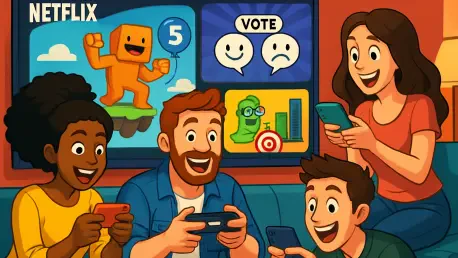What happens when a streaming giant decides to transform casual hangouts into interactive showdowns, all without extra gadgets or fees? Picture a Friday night where the TV isn’t just for binge-watching, but for battling it out with friends over a digital board game, using nothing but the smartphone already in hand. Netflix has rolled out an ambitious new feature that does exactly that, blending entertainment with social gaming in a way that’s accessible to millions of subscribers right now.
Why Netflix Is Diving into Party Games
This isn’t just another update—it’s a pivot toward redefining home entertainment. With Party Games, Netflix is tapping into a growing demand for shared, low-cost experiences that bring people together. As families and friends seek alternatives to expensive outings or complex gaming consoles, this feature arrives as a timely solution, turning any living room into a playground with minimal setup.
The significance of this move lies in its scale and strategy. Netflix, already a household name for streaming, is positioning itself as a one-stop shop for diverse entertainment. By integrating gaming into its existing subscription model, the company addresses a market need for inclusive fun, especially in an era where digital interaction often trumps physical gatherings. This isn’t merely about playing; it’s about fostering connection through technology.
The Broader Vision of Interactive Fun
Gaming has evolved into a cultural force, with industry revenue projected to hit $250 billion globally by 2027, according to recent market analyses. Netflix is seizing this momentum by embedding interactive experiences directly into its platform. This isn’t a sideline experiment but a calculated push to merge streaming with casual gaming, catering to subscribers who crave variety without additional costs.
Beyond just numbers, this initiative reflects a deeper understanding of user behavior. With social isolation still lingering in many communities post-pandemic, the need for at-home bonding activities remains high. Netflix’s focus on party-style games offers a digital twist on traditional game nights, making it easier than ever for groups to engage, laugh, and compete from the comfort of their couches.
Inside the Party Games Experience
At the heart of this rollout are Party Games for TV, a collection of titles playable directly on smart TVs with smartphones as controllers. Current offerings include lighthearted options like Boggle Party, Lego Party, and Pictionary: Game Night, alongside quirky challenges such as Party Crashers: Fool Your Friends and Tetris Time Warp. A soon-to-be-released title, Dead Man’s Party: A Knives Out Game, promises to add a mystery-solving flair to the mix.
Complementing these are expansions to the mobile gaming catalog, ensuring there’s something for everyone. Heavyweight releases like Red Dead Redemption, which launched earlier this year, and WWE 2K25 sit alongside kid-friendly picks such as Lego Duplo World and PAW Patrol Academy. This diverse selection underscores a commitment to inclusivity, appealing to casual players, serious gamers, and younger audiences alike.
What sets this apart is the pricing model—or lack thereof. Every game, whether on TV or mobile, comes bundled with a standard Netflix subscription, free of ads or in-app purchases. This approach not only enhances value but also distinguishes Netflix from competitors in a market often riddled with hidden fees, making entertainment truly seamless.
Voices Shaping the Gaming Shift
Alain Tascan, Netflix’s President of Games, has been vocal about the vision driving this update. “The goal is to deliver joy and interaction to members wherever they are, using devices they already own,” Tascan stated in a recent announcement. This philosophy of barrier-free access resonates strongly in an industry where complexity can often deter participation.
User reactions have mirrored this enthusiasm. A subscriber testing the feature remarked, “Hosting a round of Pictionary: Game Night with my family felt like a mini-event—it was so intuitive to set up with just our phones.” Industry observers also weigh in, noting that Netflix’s all-inclusive model could challenge norms in gaming, where microtransactions frequently frustrate players. Such feedback highlights the potential for this feature to reshape expectations around digital leisure.
Steps to Jump into the Action
Getting started with this new gaming frontier is straightforward for most subscribers. First, ensure that the Netflix app on both TV and smartphone is updated to the latest version; compatibility covers most smart TVs and recent mobile devices. Navigating to the Games section on the TV app reveals the full lineup of Party Games ready to play.
Connecting a smartphone as a controller is as simple as scanning a QR code or following an on-screen link provided by the app. These games are designed for group play, supporting 2-4 participants, making them ideal for small gatherings. For solo entertainment, the mobile catalog offers additional depth with titles ranging from action-packed adventures to creative outlets like Toca Boca Hair Salon 4.
The beauty of this setup lies in its simplicity—no extra hardware, no hidden costs. Subscribers can dive into a session of Lego Party with friends or explore Red Dead Redemption on the go, all under one subscription umbrella. This ease of access ensures that interactive fun is just a few taps away for anyone looking to spice up their downtime.
Reflecting on a New Era of Entertainment
Looking back, Netflix’s bold step into Party Games marked a turning point in how digital platforms approached social engagement. By leveraging everyday devices like smartphones and TVs, the company dismantled traditional barriers to gaming, inviting millions to partake in shared laughter and competition. Each title, from casual word games to immersive mobile epics, contributed to a broader tapestry of connection.
The impact went beyond mere play—it redefined value in entertainment, proving that innovation could coexist with affordability. As subscribers embraced this seamless blend of streaming and interaction, the path forward seemed clear: platforms needed to prioritize accessibility and community. The challenge then became sustaining this momentum, ensuring that future updates continued to surprise and unite audiences in unexpected ways.









